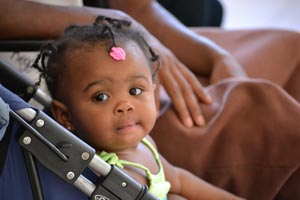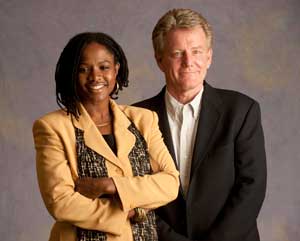The news came over a few days in December 2011: Three grants for early learning from the U.S. Department of Education totaling $88 million were coming to Minnesota.
The Race to the Top, Promise Neighborhoods, and Investing in Innovation (i3) grants focus on children at risk. Their strategies vary, but all aim to benefit children statewide by building an infrastructure for early education.
 “We have that infrastructure for K-12, and we have it for higher education, but preschool kids haven’t historically been part of public funding for education,” says Karen Cadigan, Ph.D. ’08, director of the Office of Early Learning in Minnesota’s Department of Education. “There were two reasons for that–we didn’t understand how much important learning takes place before kindergarten, and we didn’t understand the public benefit from having young children ready for school. Now we know that early education is as important as elementary school, if not more.”
“We have that infrastructure for K-12, and we have it for higher education, but preschool kids haven’t historically been part of public funding for education,” says Karen Cadigan, Ph.D. ’08, director of the Office of Early Learning in Minnesota’s Department of Education. “There were two reasons for that–we didn’t understand how much important learning takes place before kindergarten, and we didn’t understand the public benefit from having young children ready for school. Now we know that early education is as important as elementary school, if not more.”
Megan Gunnar, director of the Institute of Child Development in CEHD, emphatically agrees.
“Experiences early in life affect the quality of the brain’s architecture, creating a firm or weak foundation for all learning that comes later,” says Gunnar. “Studies of early development show the achievement gap is in place long before children reach school. To close that gap, we need to invest in the development of our youngest citizens. These three grants are an excellent start.”
The grants could not have come at a better time. The Minnesota Early Learning Foundation–a coalition of top business leaders, early-education specialists from the University, and early-education providers–was about to sunset. The group was formed because of accumulating research that shows the powerful long-term return on investment for dollars spent on early learning–and the staggering cost of failing to invest in young kids. Yet those programs are often among the first to be cut in hard times.
A pilot project funded by MELF in fact played a big role in attracting the federal dollars to Minnesota by focusing on two key initiatives: developing a voluntary four-star rating system for early-education programs, and providing scholarships for children to attend the best programs to ensure access. Minnesota was the first state to tie scholarships to such a rating system.
“These grants were not awarded by lottery,” says Art Rolnick, MELF organizer, former Federal Reserve vice president, now a University fellow. “We won them based on years of hard work and commitment by many early-childhood advocates around the state. But the trifecta–that’s really something.”
The College of Education and Human Development is the recipient of one of the grants–the i3–as part of an interdisciplinary collaborative. For all three grants, CEHD played a role in the proposals and will be engaged in implementation.
“Our funders are partnering with us in the belief that things can really change, so the name of the game is outcomes,” says Sondra Samuels, CEO of the Northside Achievement Zone in Minneapolis, recipient of one grant and a site for another. “Our anecdotal stories don’t cut it.
“We partnered with the U’s Center for Early Education and Development because our funders have confidence in the measures they are helping us to develop,” says Samuels (in photo). “All our partnerships are important, but our other partnerships succeed or fail based on the effectiveness of the evaluation and accountability system the University is helping us to create.”
CEED’s role in both the Race to the Top and Promise Neighborhoods grants is strengthened by its presence at the University’s Urban Research and Outreach-Engagement Center (UROC) in North Minneapolis.
 Race to the Top Early Learning Challenge grant: $45 million over five years to help build Minnesota’s infrastructure to improve outcomes for preschool children
Race to the Top Early Learning Challenge grant: $45 million over five years to help build Minnesota’s infrastructure to improve outcomes for preschool children
This grant will expand efforts to improve quality of early childhood programs, as well as access to those programs for high-risk children, in all areas of the state. CEHD’s Center for Early Education and Development (CEED) helped obtain the grant and will have a role in implementing it.
“You have a lot of children who are living in poverty in both urban and rural situations,” says Scott McConnell (in photo), professor of educational psychology and a CEED faculty affiliate. “The goal is to improve school readiness, to improve outcomes, for all Minnesota’s young children.”
The Early Learning Challenge grant will build a statewide infrastructure to help families. It will focus some of its work in Hennepin, Ramsey, Blue Earth/Nicollet, and Itasca counties. Included is Minneapolis’s Northside Achievement Zone (NAZ), which has the state’s highest poverty rate.
It will mean, for example, a new chance for three- and four-year-olds to enroll in high-quality preschools, where they will have sustained access to books, educational toys, and skilled teachers. A system that rates early childhood programs and reports findings to parents will be extended statewide so all parents can find high-quality programs. The grant will also fund scholarships for low-income children, plus monitoring of preschools and efforts to improve those of lower quality.
Promise Neighborhoods grant To the Northside Achievement Zone (NAZ), a collaborative that includes CEED, Minneapolis Public Schools, and 50+ community organizations: $28 million over five years; focuses on families to boost children’s success
This initiative is an all-out drive to give children the support they need to get ready for college, starting at birth. That includes ensuring access to strong schools, engaged and empowered families, comprehensive support for academic success, and building a culture of achievement.
One key to the effort is ensuring an engaged and nurturing home environment. To do that, NAZ will help parents and other family members remain active players in their children’s lives. NAZ parents will work with peer coaches to get ongoing assistance in setting and reaching goals for their children and families, and finding existing resources. As families are introduced to neighbors with like-aged children, they will find new friends who share aspirations.
Whatever the need, Promise Neighborhoods aims to reach 1,200 families in the NAZ, according to McConnell. Children who may not otherwise have had the chance will now find early care and education settings “that receive more resources to improve the quality of care, and that will become part of an ongoing quality improvement system,” says CEED co-director Amy Susman-Stillman.
“Children will benefit because their caregivers will be more knowledgeable and skillful about how to prepare them for kindergarten,” she says.
Investing in Innovation (i3) grant: To the Human Capital Research Collaborative (HCRC), a partnership of CEHD, the Humphrey School of Public Affairs, and Federal Reserve Bank of Minneapolis, with 10 education and nonprofit partners; $15 million over five years to expand the Child-Parent Center model, a proven preschool-through-third-grade intervention, in three states
The Child-Parent Center (CPC) education program began in Chicago in 1967, shortly after Head Start. CPC gives children in low-income neighborhoods an intense, continuous system of educational and family support.
“It starts with a very strong preschool program that emphasizes early literacy and parent involvement,” says project director Arthur Reynolds, Institute of Child Development professor and HCRC co-director. “Kids will see parents more at school, interacting and attending workshops with other parents, volunteering in the classroom, and furthering their education and career training. These are key to promoting school-family partnerships.”
Comprehensive services include small classes, professional development, and curriculum alignment. An evaluation of the implementation and impact of the program will be conducted.
Reynolds directs the Chicago Longitudinal Study, which began in 1985 and established CPC’s effectiveness. It helped convince the U.S. Department of Education that investment in this kind of effort yields high dividends in terms of productive citizens down the road.
“Cost-benefit analysis indicates a return of $8 to $11 per dollar invested in the program, which is among the highest of any social program,” Reynolds notes. “The duration and intensity of this exemplary intervention will enhance excellence in school and reduce the large achievement gaps that exist by family socioeconomic status.”
Read more about the Investing in Innovation grant in “How i3 came to Minnesota.”
Story by Gayla Marty, summer 2012. Adapted from “Three-pronged push for children,” by Deane Morrison, in UMNnews.
Top photo by Jillian Kahn, Northside Achievement Zone. Other photo of Sondra Samuels and Scott McConnell, by Scott Streble, courtesy of UROC.



